Angola….my 6th play. I must admit to being a bit of a jerk when it comes to multi player game (MPG). I know, I hear you say “Kev a jerk…pfft cannot imagine it!”
Edit- Note some text in the images refer to UNITA/MPLA that should be UNITA/FNLA
But many MPG’s leave me flat. Usually if it is a block game the same tired old combat system is rolled out, and a set of ‘clever’ areas are slapped over a map of some historical period. The inevitable historical events cards are added for flavour. Operations, events, actions yaddah yaddah. Why is Angola different?
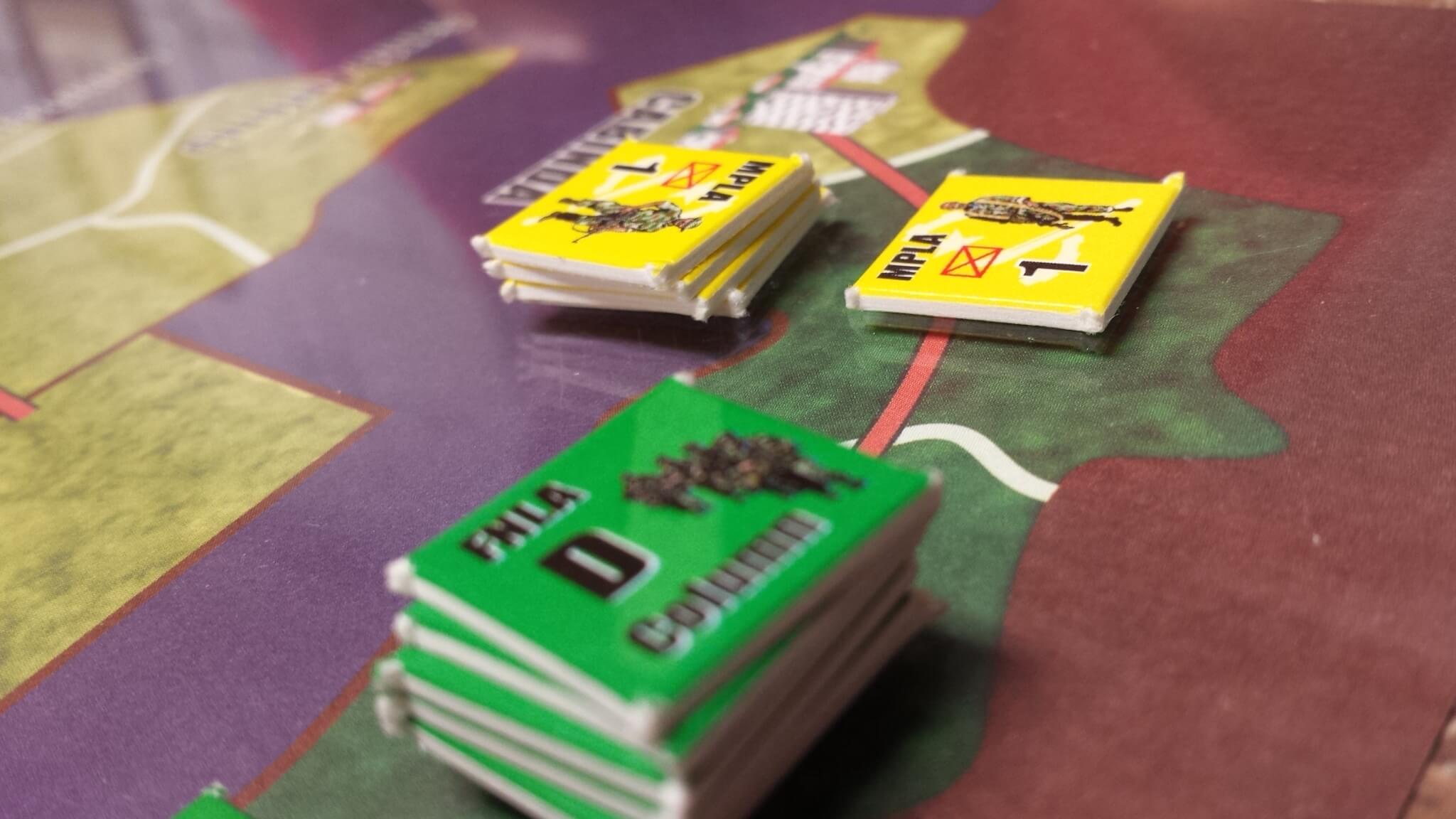
It is not often that a game system is created from scratch for multi player specific action that is designed to capture the essence of a given conflict without resorting to tried and true ‘stuff that works’ mechanics. Angola from my experience is one such title that went the distance to make something special.

So over a year ago when my gaming buddies trotted out Angola, with its garish card covers, simplistic art work and bulky looking map I just sighed and said…”ok, I’ll do it for the team, but can we please play a hex and counter game next?”
[Note, I have written about this before on the blog, and you can find lots of detail about the game on BGG. It is one of just other 3 titles on the conflict, Nova Games from ’79 is a hex and counter conventional forces effort, one battle in an S&T magazine by Miranda being the designer and his 2nd effort a point to point CDG from Decision Games called Angola Raiders.]
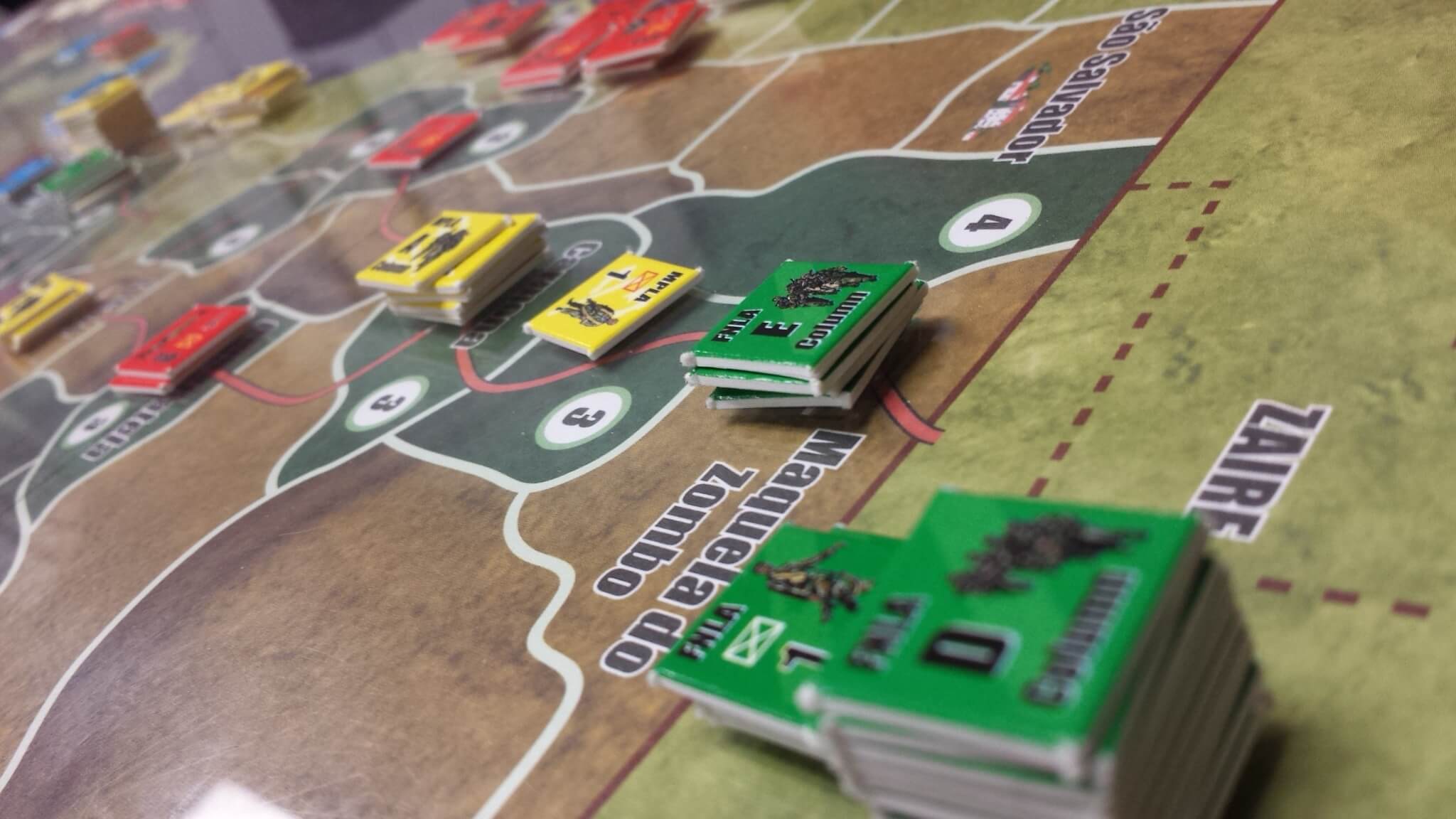
Our first one or two plays were characterized by some errors and oversights on our part. However we walked away thinking about how to win as a certain faction next time! I was impressed but not convinced, what was it that made this better than other games that were MPG specific?
Was it the roll for sides to start, combined with random political control allocation via drawing towns from a cup that made it so amazingly fresh each time?
[Note: that core cities are allocated but 3-4 townships per side are randomly allocated via the cup of choice to represent the chaotic nature of this two and from struggle]
Or was it the fact that you used a set number cards to activate columns of forces each turn? This number of cards and the number of times certain columns could activate changed upwards as the game progresses from 4 cards to 7 in the final turns, showing the increased tempo of the war. [Note: each side has a slightly different mix, and column counters can be re allocated during turns via card play and during a re organization phase]. So turns go from a brisk 10-15 minutes a turn to panic filled tense 45 minute turns for about a 4-5 hour game in total.
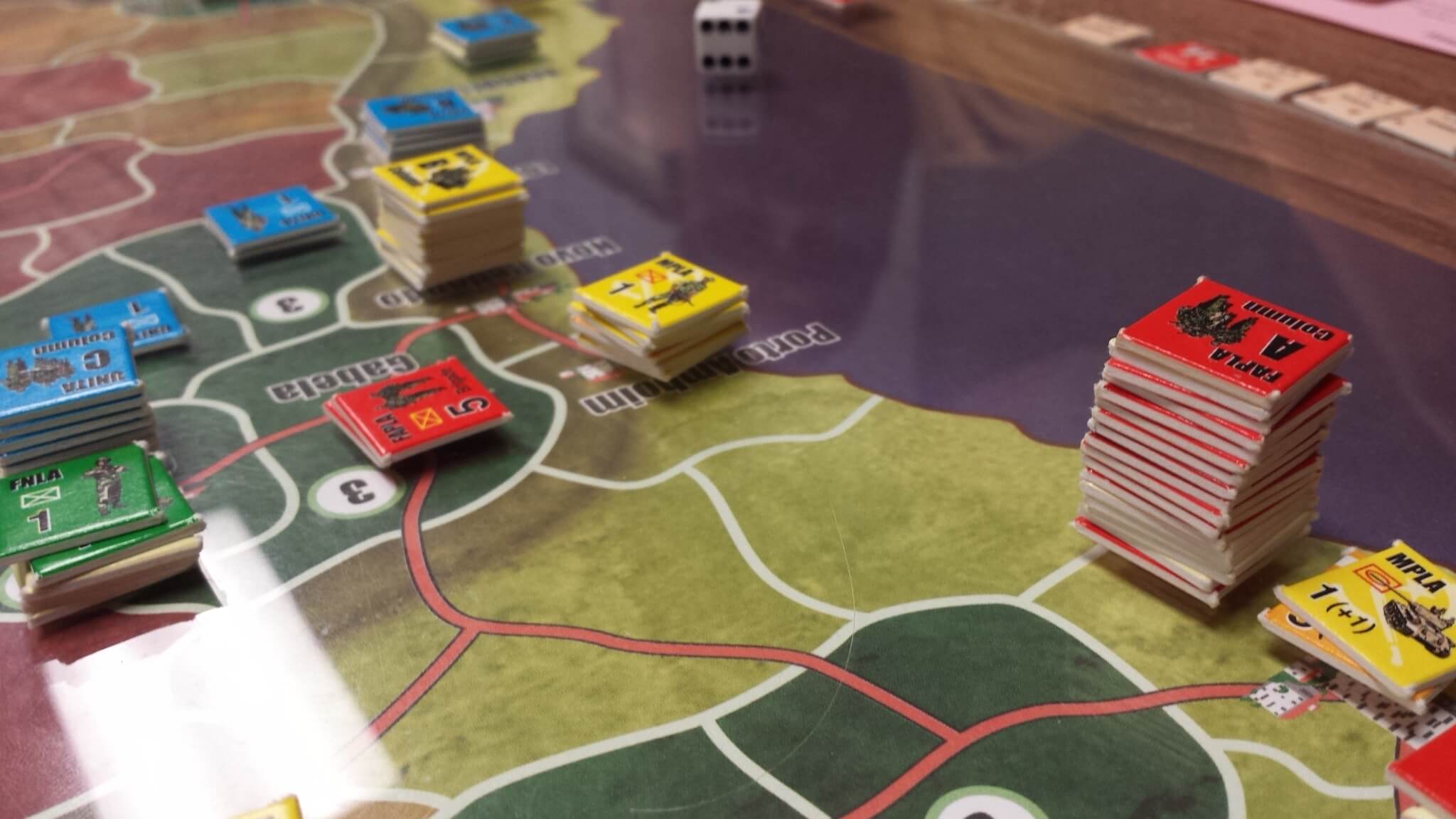
You must to choose your plan of action for the turn [sequence of playing the cards for the turn] before you know what order you will play in. Yep! The four factions order of play changes nearly every turn on a simple 1d6 roll [5,6 rotate one clockwise, other rolls go direct to a given faction].
This means that your plan may go awry or be enhanced subject to when you actually start playing cards! This forces you to select the most critical actions first or hope for the ability to execute going last, praying your enemies have not noticed you feverishly counting your forces and area moves slyly on the side.
I cannot speak for the other guys but these factors sure weigh into the game, but there are a few more elements that set this title apart.
The game also throws in more elements that cause uncertainty. First the end of turn political aid. Here you make a stark choice. Request the aid you desire hoping that the cards dealt are what you really need and pay the price in terms of a Victory Point or ask for a minimal amount of covert support and hopefully survive on it but pick up a VP if the enemy chose to request big. Nothing sucks more than to low bid and end up with neither side losing a VP, because they both low bid.
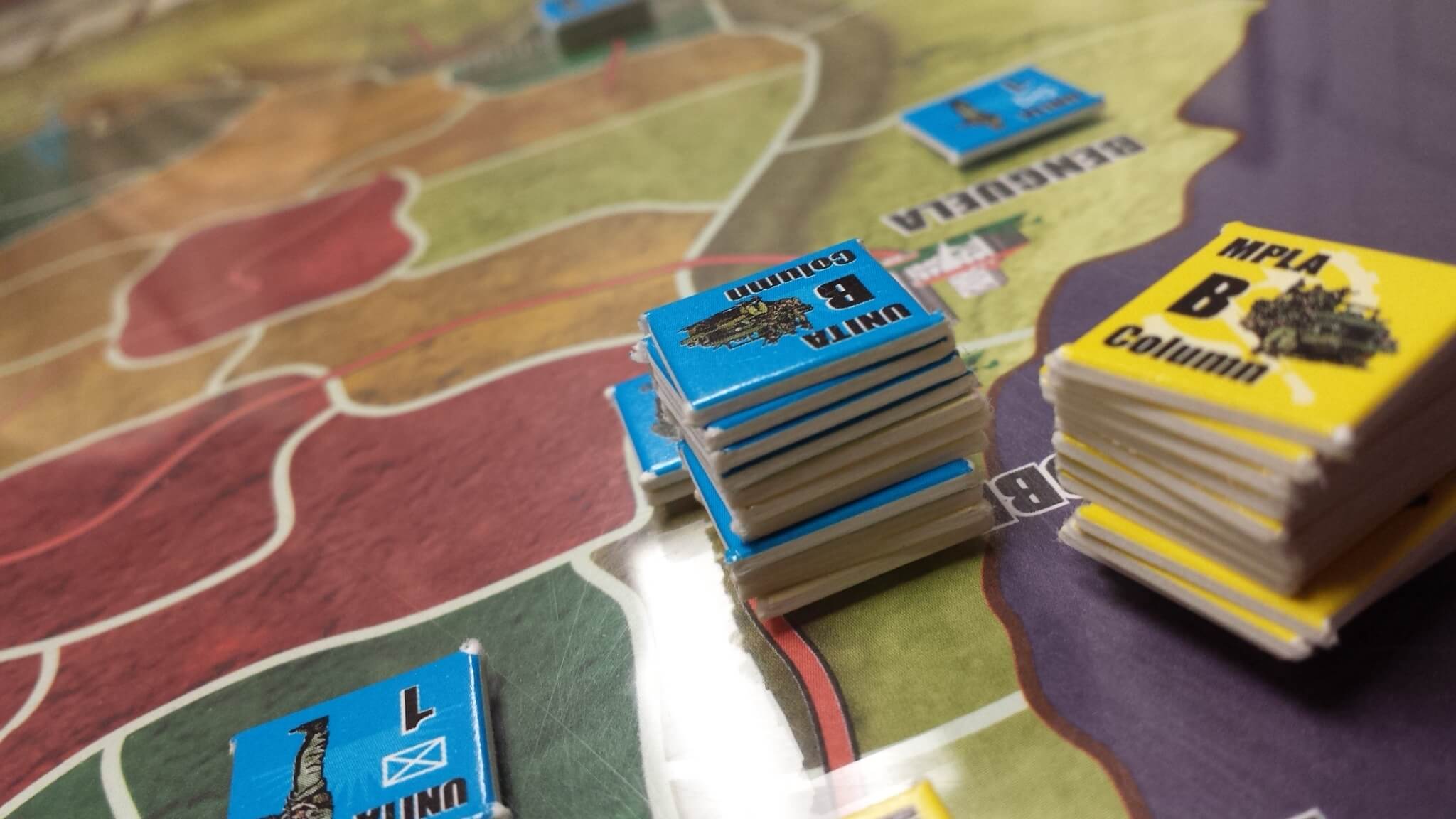
Covert aid brings the addition of Airgroups, Arty, minefields, AA and AT weapons all critical to success for all sides, but how much to take and when to take it? [Game play tip – we found in our 5th and 6th play, that the go ugly early and grab what you can at the expense of a VP or two allowed you to garner more finite goodies, which does 2 things -one it stops the other guy from getting minefields and AT guns and AA. Two it provides you with the ability to go and capture towns or cities with the added resources while building up defenses of vital areas or road junctions.]
Which leads us to the final aspect that is intriguing and related to the above. The Victory conditions.
Each coalition is joined at the hip in this game. FAPLA/ MPLA must win together as does the other alliance.
The winner is the first to earn more VPS than listed on the turn track in a given turn. Earning VPs moves you DOWN the VP count. So if you made it to 10 first you win (I think;)).
With each town taken worth 1 VP token, and Cities worth two and a total of 20 tokens (5 each faction) it is very hard in the early game to take enough tokens from the enemy to garner the 20,19, 18 VPs count. It is not until around turn 4 when both sides are typically within one or two VPs in the 17-15 range that things start getting interesting. Why?
Well you do not want to be winning by too great a margin. Because if the margin is too substantial then your enemy receives actual hard core reinforcements from Cuba the West- real armies not militia style forces. These type of units receive DRM bonus’s in combat and pack a wallop. They also included massive arty units that can wipe out smaller militia columns in toto.
A Victory margin in any turn of more than one or two can be very detrimental to the winning side.
We saw this in this 6th play thru, where FAPLA picked up a massive Arty unit and Tanks due to over zealous action by UNITA/FNLA. This gave FAPLA/MPLA the respite required to rebuild forces, accrue some smaller towns and re join the fight in Turns 5-6.
In fact in Turn 6 the Communists were well on their way to a victory, when they picked up about 12 VPs to our 8. This reversal put them ahead of the Western allied factions by one VP after lagging well behind, but this consequently allowed both UNITA and FPLA to pick up one or two tough units for themselves. re-balancing the force mixes.
So the idea here is to win carefully! In some respects it is a viable approach for MPLA/FAPLA to go hard early and acquire key choke points and Cities. Some towns prevent access to vast areas of the map, others are important as they are both Cities and Ports where reinforcements may land. By driving the VP total hard, they may force UNITA/FNLA to seek more covert aid, accelerating the Communist VP count! They will however forfeit the major reinforcements, and give extra manpower to an already formidable set of foes.
If the opening play is to acquire towns aggressively it likely needs to be coupled with a smashing of UNITA as a fighting force. Both UNITA and FNLA receive lots of reinforcements but at the extremes of the board edge, making North/ South Routes a priority to hold to slow down the building of Western proxy fighters.
As the inevitable Western Build up occurs the Commies can then slowly cede ground allowing turns to be lost, and pick up VP’s AND Major Units from the West that will hopefully allow one last push to grab that decisive VP count in the 13-11 range of a turn (Meaning that the Soviet player may only require 2-3 townships or a City to bag the game if they can hold everything else they currently own.
I focus on this as in all of our games to date the West has won. In this 6th game it was no different. But EACH time we play the Communists come very, very close. The margin for error as one of our Players Pete mentioned is almost zero for the Soviet backed Alliance.
Yes, despite this game appearing to be an unbalanced load of B.S. it is in fact such fun and so tense that you really never think you are going to lose!
As I re read this post quickly, I notice I failed to mention anything about the combat system. Deceptively simple in execution the combat provides those with massive forces, suitable benefits but also injects a sense of technological and weapon system superiority with DRMs or modifiers for quality of force, terrain and supporting areas aiding the fight by providing DRM’s for them as well. This coupled with Air and Arty to suppress or kill combatants leads to a sliding scale of losses expressed in ratios of 1/3,1/2 and 2/3 of units lost with retreats inflicted also.
Sequencing of the combat in critical to ensure you give each force type its moment to shine and this will require you to adhere strictly to the sequence of play. The Rules are straight forward, but will require you to walk thru them once or twice while shoving a chit, as some aspects are not obvious at first read.

Some loose ends:
I mentioned maps and counters being simple and garish. The art is stark. But it conveys a sense of unrelenting uniformity of Savannah, grasslands jungle and coast. After the 2nd play I warmed to it. The cards could be thicker stock, the counters are decent sized with mostly accurate depictions of weapons platforms for the various sides, from T-55’s to F-14s. It really does all come together nicely. We did create a couple of play aids that we use that Cisco made for us: Combat , and Column Management. There is also a AAR sheet that needs some enhancement too .
Finally what about narrative Kevin? You always poop on games for being generic or lacking narrative and theme!
Relax, if you cannot imagine in your minds eye, hordes of Toyota pickups racing thru the jungles and dusty trails of Angola, engaging in hostilities in urban settings while being attacked from the air by screaming jets or hunkering down as whirling RPG’s splattered your Armoured Cars to hell, then you may as well go play Settlers of Catan.
The designer Phil Kendall has done a superb job with this game and I do not usually make recommendations as such and this is weird for me as I do not actually OWN the game! [Our group owns three copies so there is not much point in buying another!]. I will just say this, if you can find 4 players to play this with; get the darn game.
We are busy scheduling our next session where we will not roll for sides but the victorious West will now take all it learnt and attempt to win as the Soviets.
This is the 2nd best multi player wargame out there I have experienced.
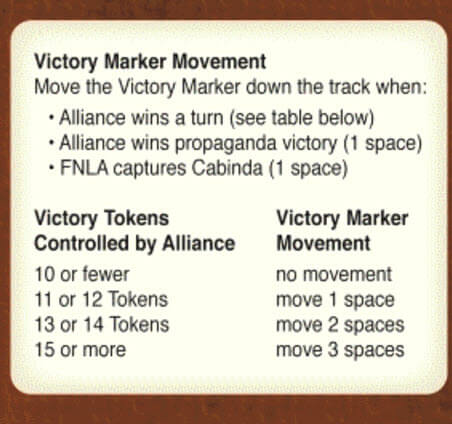

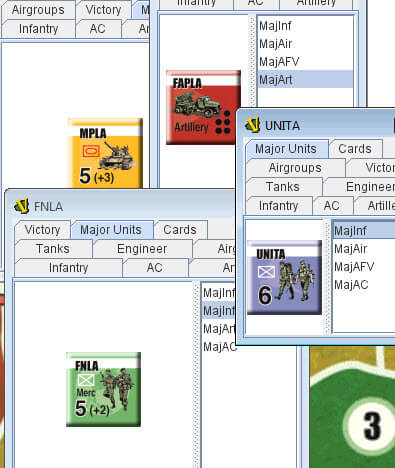
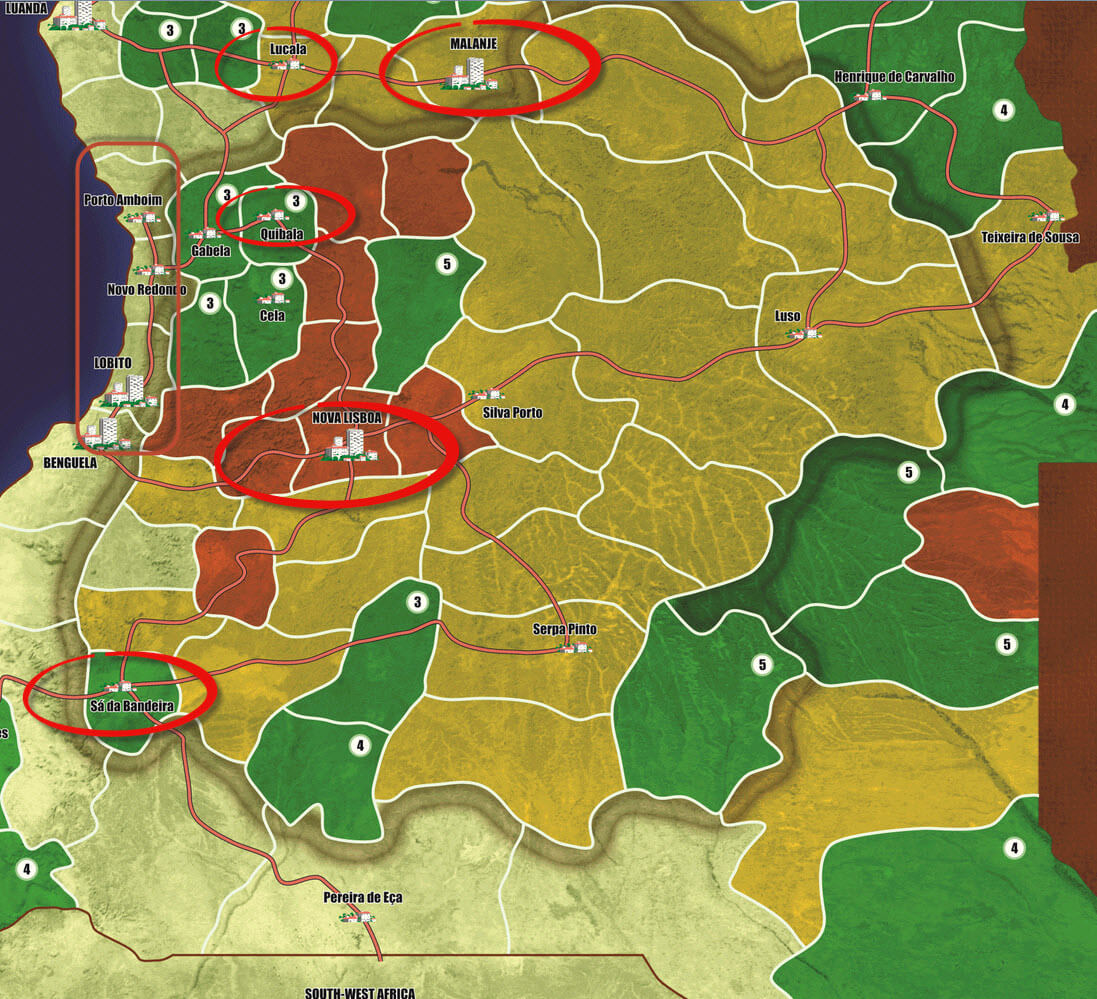
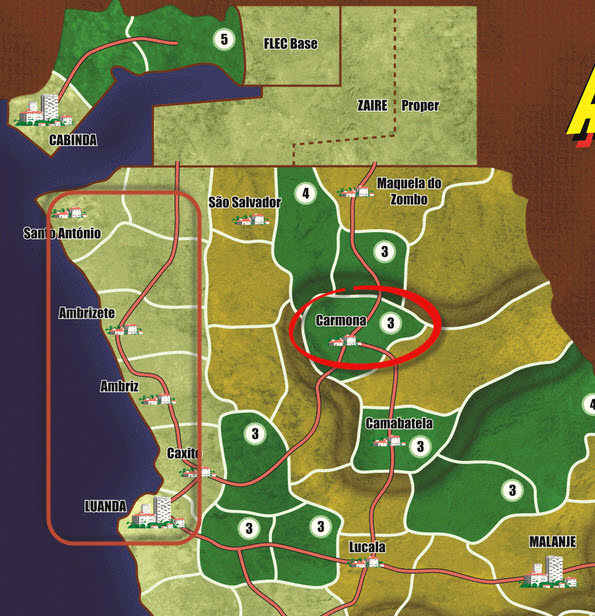
This one is on my list of games to play since I read the review in Battles Magazine. It’s a subject seldom covered, but one I studied extensively in graduate school. The problem, of course, is getting five other people to get together for a session… (I’m not a fan of playing over the net, I prefer FtF)
you just need 3 more players.
we played multi player 4 player!!! IT was fun.
What kind of plexiglass do you use?
no idea. Not my plex for this play thru. It was my buddies. It is nice nad thin, but ver glary and the place we played had horrid glare too.